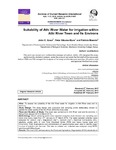Suitability of Athi River Water for Irrigation within Athi River Town and Its Environs

View/
Date
2016Author
Aywa, John O.
Gikuma-Njuru, Peter
Muendo, Patricia
Metadata
Show full item recordAbstract
Aims: To assess the suitability of the Athi River water for irrigation in Athi River area and its
environs.
Study Design: The study design was purposive with sampling points deliberately chosen to
assess the water quality of the Athi River within the study area.
Place and Duration of Study: The study was carried out in Athi River town and its environs in
Kenya from January 2015 to March 2015.
Methodology: Seven sampling points were selected along the study transect and sampling was
done once every week from 21st January to 6th March 2015. The water samples collected were
analyzed for sodium (Na+
), Magnesium (Mg2+), Calcium (Ca2+), Electrical Conductivity (EC),
alkalinity, acidity (pH), E. coli, Total Dissolved Solids (TDS) and heavy metals (lead and
Chromium). Field observations and administration of questionnaires were used to identify major
sources of pollution into the river. The data so collated and collected was analyzed using SPSS
and Microsoft Office Excel.
Results: The level of E. coli was above the Food and Agricultural Organization (FAO) standards at all sampling points (M=1,073-2,202 MPN). The levels of all physico-chemical parameters
measured were within the recommended limits. However there was an increasing trend in the
concentration of most of the parameters along the study transect, an indication the impact of
pollution input from the Athi River area on the river water quality. 42.9% of the sites sampled had a
moderate sodicity hazard while 100% of the sites sampled had a moderate alkalinity hazard.
Conclusion: The Athi river water within Athi River is polluted with E. coli and it is recommended
that the public is sensitized on the health risks paused by the high concentration of E. coli in
irrigation water and encouraged to adopt risk minimization strategies. It is also recommended that
periodic monitoring of river water quality be done and pollution control measures should be put in
place.
